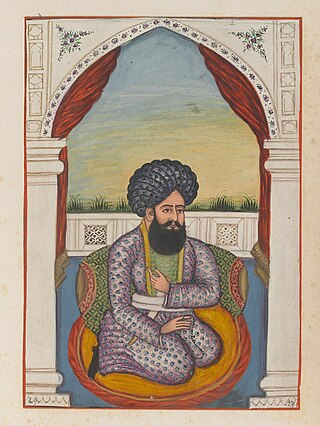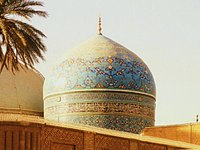
Sayyid is an honorific title of Hasanids and Husaynids Muslims, recognized as descendants of the Islamic prophet's companion, Ali through his grandsons, Hasan and Husayn.

The Naqshbandi order is a Sufi order of Sunni Islam named after Baha al-Din Naqshband. They trace their silsila to Prophet Muhammad through the first caliph Abu Bakr by the way of Ja'far al-Sadiq. The Naqshbandi Sufi order is most distinguished from other Sunni schools by the high level of importance they assign to the sharia, highlighted by major Naqshbandi scholars such as Ahmad Sirhindi and Shah Waliullah Dehlawi.

The Qadiriyya or the Qadiri order is a Sunni Sufi order (Tariqa) founded by Abdul Qadir Gilani, who was a Hanbali scholar from Gilan, Iran. The symbol of the order is the rose. A rose of green and white cloth, with a star in the middle, is traditionally worn in the cap of Qadiri dervishes. Robes of black felt are customarily worn as well. The names of God are prescribed as chants for repetition, or Dhikr, by initiates.

Mirzā Mazhar Jān-i Jānān, also known by his laqab Shamsuddīn Habībullāh, was a renowned Hanafi Maturidi Naqshbandī Sufi poet of Delhi, distinguished as one of the "four pillars of Urdu poetry." He was also known to his contemporaries as the sunnītarāsh, "Sunnicizer", for his absolute, unflinching commitment to and imitation of the Sunnah.

The Naqvis are people found predominantly in Iran, Iraq, and the South Asian countries. They claim descent from the Imam.

Qadiriyya wa Naqshbandiyya is a Sufi order which is a synthesis of the Qadiri and Naqshbandi orders of Sufism. The Qadiriyya wa Naqshbandiyya Sufi order traces back through its chain of succession to Muhammad, through the Hanbali Islamic scholar Abdul Qadir Gilani and the Hanafi Islamic scholar Shah Baha al-Din Naqshband, combining both of their Sufi orders. The order has a major presence in three countries, namely Pakistan, India, and Indonesia.

Khwaja Haji Dost Muhammad Qandhari was an Afghan Sufi master in the Naqshbandi tradition in the 19th century (1801–1868).

Shah Abdullah alias Shah Ghulam Ali Dehlavi was a Sufi Shaykh in Delhi during the early 19th century. He was a master of the Naqshbandi tradition His father wanted to make him a disciple of Qādri,.

Shah Inayatullah, popularly known as Sufi Shah Inayat Shaheed, Shah Shaheed or Shah Inayat of Jhok, was a 17th-century Sindhi Sufi saint and revolutionary from Jhok. He was the first socialist and agricultural reformist of Sindh.

Ghawth SayyidMir Jan Shah Saheb ibn Hasan Naqshbandi Ishaani was a Sunni saint from Kabul and contemporary supreme leader of the Naqshbandi Tariqa and Naqshbandi Ishaani Sub-Tariqa as the 7th hereditary successor of his ancestor Hazrat Ishaan.

Pir Syed Jamaat Ali Shah was a Pakistani author, Islamic scholar and Sufi saint of the Naqshbandi Order. He presided over the All India Sunni Conference and led the Movement for Shaheed Ganj Mosque. He was a contemporary of Ahmed Raza Khan Barelvi, the founder of Barelvi movement.

Hazrat Ishaan Mahmud bin Sharif bin Zia bin Muhammad bin Tajuddin bin Hussein bin Zahra binte Bahauddin Naqshband was an influential Sunni saint from Bukhara, Uzbekistan and hereditary supreme leader of his ancestor Bahauddin Naqshband's Sufi Order, the Naqshbandiyya.

Sultan Mohammad Khan, also known as Ghazi Sardar Sultan Mohammad Talaei, and known by his epithet, Sultan Mohammad Khan the Golden was an Afghan chief minister and regent. He was a powerful brother of Emir Dost Mohammad Khan, the eventual ruler of Afghanistan who seized control of Kabul from him. Prior to and during the reign of Dost Mohammad Khan, Sultan Muhammad Khan Telai was chief minister and governor of various regions of Afghanistan, including Kabul, Peshawar and Kohat. He was the first of the Musahiban, a Mohammadzai dynasty that began with him and ruled Afghanistan for more than 150 years, in various forms such as emir, king or president from 1823 to 1978.

Mir Sayyid Mahmud Agha, officially known as Sayyid ul Sadaat Mir Sayyid Mahmud Saheb Agha ibn Mir Hasan Naqshbandi al-Hasani wal-Husseini was a Sufi saint of South Asia. He was the brother of Sayyid Mir Jan and acted under him as Grand Master of the Naqshbandi Sufi order. Together with his brother, he preached the legacy of their ancestor Hazrat Ishaan.
Sayyid Ali al-Akbar ibn al-Hasan was a Sunni Muslim saint, and according to some historians of genealogy the second son of Imam Hasan al-Askari, the eleventh Imam in Shia Islam. He was also the brother of the twelfth Imam Muhammad al-Mahdi. His existence was hidden because of contemporary political conflicts with the political leadership of the Abbasids, reaching its peak at that time.

Sayyid ul-Sadaat Sayyid Moinuddin Hadi Naqshband al-Hasani wal-Husseini, known as "Hazrat Naqshband Saheb", was a Sunni Muslim wali (saint) from Bukhara and direct descendant of Muhammad, through his father Hazrat Ishaan who was a seventh generation descendant of Bahauddin Naqshband. Moinuddin Naqshband succeeded his father in leading the Silsile Aliyya Naqshbandiyya.
Sayyid Mir Fazlullah bin Sayyid Mir Hasan Naqshbandi was a Sunni Saint and Mir and the highest Qadi and Grand Mufti of the Emirate of Afghanistan.
Mir Sayyid Hasan ibn Azimullah was an Emir of a group of Sunni Sayyids of Khorasan, following the Sayyid ul Sadatiyya heritage. His descendants were confirmed as Emirs of the Afghan Sayyids and custodians of the Hazrat Ali Shrine by the Muhammadzai Royal Dynasty.

Khwaja Sayyid Mir Alauddin ibn Muhammad Attar, was a Sufi Saint from Bukhara and Qutb of the Naqshbandi Sufi order. He was a descendant of Muhammad and son in law of his master and predecessor Khwaja Bahauddin Naqshband.

Sayyid Kastir Gul (1573–1653) was an Islamic jurist and Sufi saint who is revered among Afghans and Pakistanis. He is the patriarch of the Kakakhel tribe.













